|
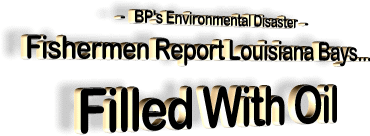
by Dahr Jamail and Erika Blumenfeld
27 October 2010
from
Truth-Out Website
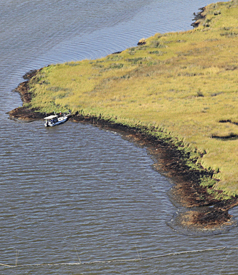
Oiled marsh in Bay Jimmy, Louisiana.
(Photo: Erika Blumenfeld)
On Saturday, October 23, Truthout spotted what appeared to be
massive areas of weathered oil floating near Louisiana's fragile
marshlands in both East and West Bays along the Mississippi River
Delta.
In addition, at least two more oil leaks were spotted near
oil and gas platforms along Louisiana's embattled coastline.
Four days prior, federal on-scene cleanup coordinator for the BP oil
disaster, Coast Guard Rear Adm. Paul Zukunft, declared there was
little recoverable surface oil in the Gulf of Mexico.
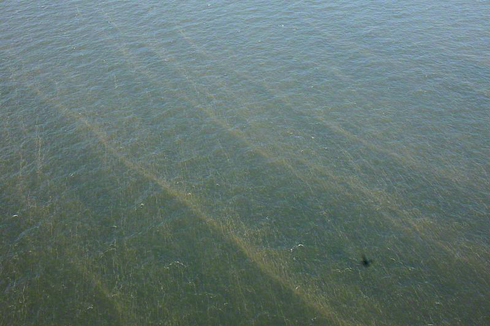
Miles-long strands of what appears to be weathered BP oil in bays
near Southwest Pass, Louisiana.
(Photo: Erika Blumenfeld)
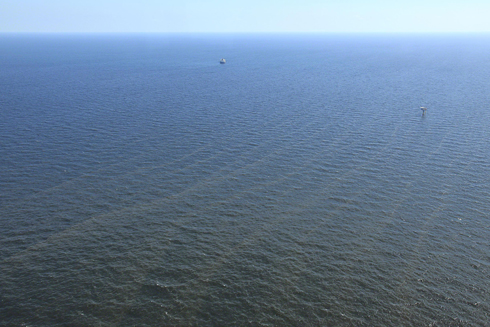
Another view of miles-long strands of what appears to be weathered
BP oil in bays near Southwest Pass, Louisiana.
(Photo: Erika Blumenfeld)
Both Bays cover an area of roughly 70 square miles of open water
that surround Southwest Pass, the main shipping channel of the
Mississippi River.
While East Bay remains closed for fishing, West
Bay was currently open for fishing when Truthout spotted the
substance on October 23, despite the fact that the day before a BP
oil cleanup crew had reported oil in West Bay to a local newspaper.
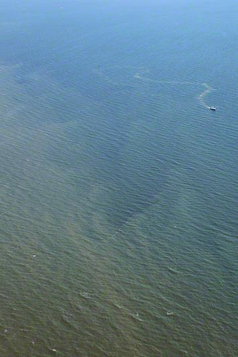
Shrimper trawling in oil, in West Bay, Louisiana.
(Photo: Erika Blumenfeld)
"They are literally shrimping in oil," Jonathan Henderson, the
coastal resiliency organizer of the environmental group the Gulf
Restoration Network, who was with Truthout on the flight, exclaimed
while our plane flew near the fishermen.
"Our tests continue to reveal seafood from the reopened areas is
safe to eat," Jane Lubchenco, US National Oceanic and Atmospheric
Administration (NOAA) administrator,
told reporters while NOAA
recently opened more federal waters in the Gulf.
The day before Truthout's oil sighting, NOAA had reopened more of
the previously closed fishing areas, bringing to 96 percent the
federal waters now deemed safe for fishing.
The waters in East and West Bay are under the jurisdiction of
Louisiana's Department of Wildlife and Fisheries (LDWF), while
waters further from the coast are under federal jurisdiction. LDWF
does receive input, however, from NOAA.
Earlier in the same day, Truthout spotted the substance.
A spotter
pilot for LDWF had flown over the same area and told Southern
Seaplanes there was no oil.
"He is the spotter for LDWF and saw that bay, and it is still open,"
Henderson told Truthout.
"He should have closed the Bay for fishing.
So now you can see how sophisticated they are in tracking this.
Either this guy is completely incompetent, or has an agenda to keep
as much of Louisiana's waters open for fishing as he can, whether
there is oil or not. I don't see how he could have flown down there
today and not seen it. It's criminal."
When Truthout called the LDWF requesting to talk with the LDWF oil
spotter, Truthout was told,
"that person is not available to
comment."
The LDWF web site has a number to call in order to report oil
sightings.
When Truthout called that number, the call was answered
by a BP response call center.
The only federal waters of the Gulf that have yet to be reopened are
a 9,444-square-mile area directly around the BP wellhead where the
Deepwater Horizon exploded, burned and sank to the bottom of the
Gulf.
On October 23, the
Coast Guard claimed that the substance floating
in the miles-wide areas of West Bay appeared to be "an algal bloom."
Lt. Cmdr. Chris O'Neil said a pollution investigator for the Coast
Guard collected samples from the area, and while they had yet to be
tested, said,
"based on his observation and what he sees in the
sample jars, he believes that to be an algal bloom."
Fishermen who have traveled through and fished in the area over the
weekend, however, refute these Coast Guard claims.
"I scooped some up, and it feels like oil, looks like oil, is
brownish red like all the dispersed oil we've been seeing since this
whole thing started," fisherman David Arenesen, from Venice,
Louisiana, told Truthout.
"It doesn't look like algae to me. Algae
doesn't stick on your fingers, and algae isn't oily. The area of
this stuff spans an area of 30 miles, from Southwest Pass almost all
the way over to Grand Isle, and runs very far off-shore too. We rode
through it for over 20 miles while we were going out to fish, I
dipped some up, and it's oil."
Arenesen saw the substance on Friday, the same day it was reported
by the Times Picayune newspaper in New Orleans.
"It was at least an inch thick, and it went on for miles," Arenesen
added. "It would be easy to clean since it's all floating on the
surface."
Truthout spoke with Gary Robinson, a hook-and-line, mackerel,
commercial fisherman working out of Venice, who was also in the
substance in question recently.
"I was out in West Bay on October 22nd, and I was in this thick
brown foam, about five inches thick, with red swirls of oil
throughout it, and there was a lot of it, at least a 10 mile patch
of it," Robinson said while speaking to Truthout on his boat.
"I've
never seen anything like that foam before; the red stuff in it was
weathered oil, and there was sheen coming off my boat when I came
back into harbor. I'm concerned about the safety of the fish I'm
catching."
The boat captains working in the BP oil spill response team who
first reported the sightings as oil told the Times Picayune on
Saturday that they were not convinced either by the Coast Guard's
initial assessment.
"I've never seen algae that looked orange, that was sticky, smelled
like oil and that stuck to the boat and had to be cleaned off with
solvent,"
said one captain.
Last Friday, the boat captains said they were frustrated by a lack
of response from the Coast Guard, after they had been reporting the
sightings for a week.
Dean Blanchard, of Dean Blanchard Seafood Inc. in Grand Isle,
Louisiana, spoke with Truthout about the Coast Guard claim that the
substance was likely algae.
"Hell, we got oil coming in here everyday, it's all around us; we
know what oil is," Blanchard said.
"The Coast Guard should change
the color of their uniforms, since they are working for BP. We've
known they are working for BP from the beginning of this thing. None
of us believe anything they say about this oil disaster anymore."
Despite a consistent trend by state and federal governments to
promote the Gulf of Mexico as being largely free of BP oil and
dispersants, many residents remain concerned.
"Anytime you can fly 100 miles in one direction and not see a break
in the oil," Capt. Dicky Tupes of Southern Seaplanes told Truthout.
"Then fly 100 miles in the other direction and not see a break in
the oil: that's a lot of oil, and it had to go somewhere."
Tupes was discussing his experience flying over large areas of the
Gulf that had been oiled while BP's well continued to gush, yet he
remains alarmed at what he sees in the water.
"Everyone, including the feds, are talking about the fact that less
of the oil actually reached the surface than was below." Tupes
added. "And now we're seeing some of that submerged oil surface
here. How long will this go on?"
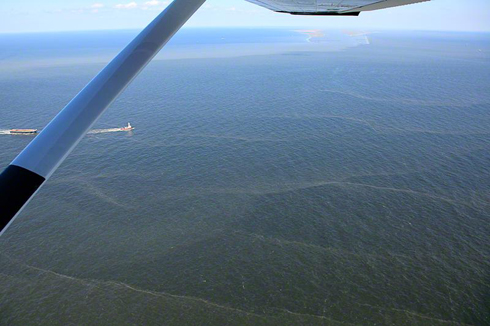
What appears to be weathered BP oil in bays near Southwest Pass,
Louisiana.
(Photo: Erika Blumenfeld)
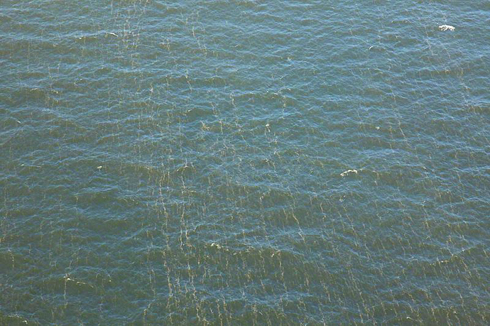
Strands of what is likely weathered BP oil in bays near Southwest
Pass, Louisiana.
(Photo: Erika Blumenfeld)
While flying out to East and West Bays, Truthout spotted a platform
with what appeared to be an oil leak, as sheen streaked the water.
The GPS coordinates at this spotting were 2925.66N, 8929.54W.
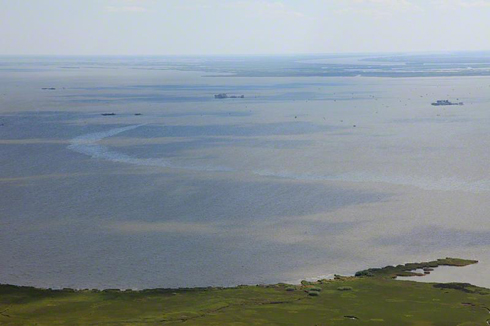
Silvery-blue oil sheen shows a leak from a facility between
California Bay and Quarantine Bay, Louisiana.
(Photo: Erika Blumenfeld)
"I've seen quite a few of these," Tupes told Truthout, referring to
the leaking platform.
Henderson explained that he had spotted oil at the exact same area
during a
previous flyover on October 19. He reported the leak at
that time to the Louisiana State Police and the National Response
Center, in addition to his speaking directly with the Coast Guard
National Response Command and emailing them his photos.
Clearly, no effective action had been taken.
Disturbingly, Henderson has recently revealed how long this leak has
been in existence.
"I found out from the Coast Guard that not only has this leak been
going on since last week, but that the first report they ever
received about this leak was on August 31st,"
Henderson wrote for
the Gulf Restoration Network on Monday.
"It gets worse. According to
the Coast Guard, 'the leak is from an abandoned underwater oil
pipeline and the State Department of Natural Resources is in charge
of investigating it.' What does that even mean? Is the State only
going to take action to stop the leak after they find the
responsible party? Are they really actively investigating this?"
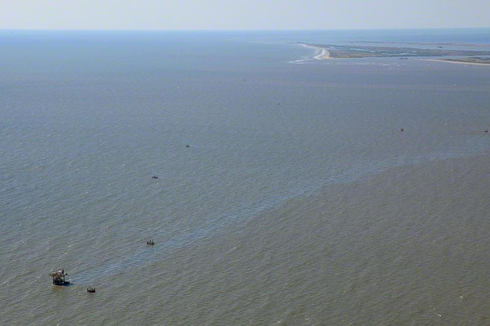
Silvery-blue oil sheen shows leak from a facility in East Bay,
Louisiana.
(Photo: Erika Blumenfeld)
Another oil leak was spotted near a platform just east of Southwest
Pass.
A long streak of sheen was visible in East Bay at this area at
GPS coordinates 2859.77N, 8917.61W.
The East Bay area was completely covered in miles-long strands of
what was likely weathered oil of various colors. While flying
approximately ten linear miles across the Bay, Truthout saw nothing
but streaks of oil across the surface, as well as submerged oil.
"That oil is covering just about the entire length of Southwest
Pass," Tupes said.
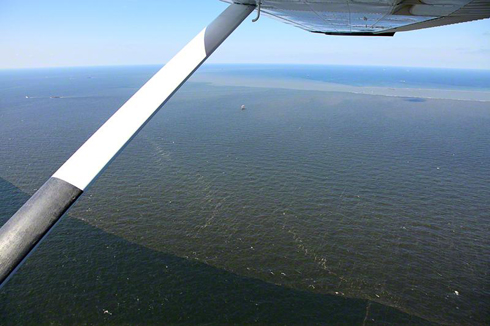
What is likely weathered BP oil in East Bay, Louisiana.
(Photo:
Erika Blumenfeld)
Just across Southwest Pass where the Mississippi River ultimately
drains into the Gulf, Truthout was flown over West Bay, which the
previous day was
reported to be covered in weathered oil by the New
Orleans Times-Picayune Newspaper.
Surprisingly, the day after this report,
neither state nor federal
authorities had closed this area for commercial fishing.
On October 21, scientists from NOAA, the LDWF and the Audubon Nature
Institute joined with Coast Guard Rear Adm. Roy A. Nash to return 33
sea turtles to Gulf of Mexico waters offshore of Louisiana.
NOAA reports claimed,
"the area is clean and a safe habitat for the
turtles."
While flying over West Bay, the amount of what is likely weathered
oil and sheen visible on the surface was staggering.
Looking west,
it covered the surface as far as the horizon into the open Gulf.
"This is unreal," Tupes exclaimed at one point.

Substance that is likely weathered BP oil in West Bay, Louisiana.
(Photo: Erika Blumenfeld)
While flying back to the airport, Truthout witnessed large amounts
of oil sheen atop the water of Bay Jimmy in Barataria Bay.
Numerous
areas of marsh were covered in oil, and much of the grass appeared
black and dead.
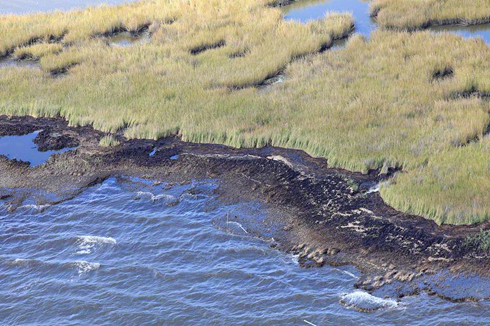
Oiled marsh in Bay Jimmy, Louisiana.
(Photo: Erika Blumenfeld)
Several BP cleanup crews were working in the area, yet Henderson had
visited the area on October 21 to find several oiled birds and much
oil heavy damage.
"This marsh is in trouble," Henderson added.
Environmental groups like the
Gulf Restoration Network are deeply
concerned about the ongoing oil findings, as the Mississippi Delta
is a primary wintering ground for hundreds of thousands of ducks and
geese, some of which already have begun arriving.
The West Bay area
leads into several shallower interior bays that attract ducks, geese
and myriad species of shore and wading birds each winter.
"What you don't see anymore out here are ducks," Tupes said. "It
used to be that there were so many ducks they'd darken the sky. Now
you don't see anymore of that."
Henderson is angered by what he saw Saturday.
"Much of the water we
flew over today was open for commercial and recreational fishing,"
he said of the flight.
"We saw shrimp boats trawling in a bay full
of oil. We were under the impression that the science advisor for
the Louisiana Department of Wildlife and Fisheries had gone out to
assess the situation in West and East Bays, to determine if they
should be closed. What we ascertained from conversations with
aviators flying through these waters today was that that scientists
had gone out and then returned and reported these waters clear."
Henderson paused, then continued,
"But we went out and flew over
these same areas and sensitive marshlands and found them completely
covered in oil, and with shrimp boats trawling in them. Honestly, I
don't have any kind words for the LDWF, and I'm at a juncture where
I'm losing faith in any assessments that are done by our state or
federal governments."
"I would not eat the shrimp right now," Henderson added.
"They are shrimping in oil. Where were all the spotter planes? Where was the
boom and skimmers?
There was clearly skimmable oil on the surface,
and they were doing absolutely nothing. Why is there not a more
concerted effort to fight this? How is it that BP gets to make the
decision to remove what defenses we have against this oil that keeps
coming in?"
|











